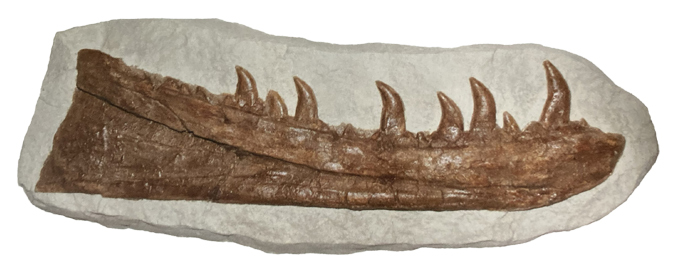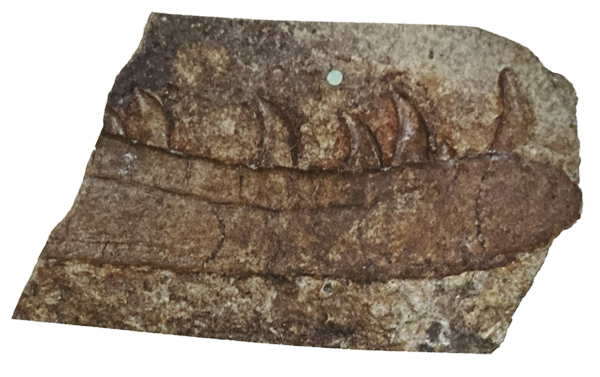New Triassic Dinosaur Identified from the National Museum of Wales Vertebrate Collection
A remarkable fossil discovery has been made in Wales. Palaeontologists have identified a new, Triassic dinosaur species named Newtonsaurus cambrensis. The fossil was first reported back in 1899, yet it was never properly studied until now. The fossil material had been referred to in many scientific papers. A scientific name had been erected – Zanclodon cambrensis by the British palaeontologist Edwin Tully Newton. This name is not valid, the genus name having been used previously to describe an archosauriform from southern Germany.
Using modern, digital scanning techniques researchers have been able to confirm that the fossil material represents a theropod dinosaur. Owain Evans, a student at Bristol University, created a three-dimensional digital reconstruction of the dentary material. The fossil is preserved as natural moulds, with the original bone lost. By digitally scanning and fusing the moulds, the team rebuilt the jaw in striking detail. Every ridge, groove, and serrated tooth was revealed.
The new name honours Edwin Newton.

A plaster cast of the left dentary of Newtonsaurus cambrensis. Picture credit: BGS NERC from “Dinosaurs of the British Isles” by Dean R. Lomax and Nobumichi Tamura.
Picture credit: BGS NERC
Newtonsaurus cambrensis
Writing in the Proceedings of the Geologists’ Association, the researchers suggest that the fossils represent a neotheropod similar to Liliensternus and Dilophosaurus. The jaw was over half a metre long. This suggests a theropod of approximately five to seven metres in length. Poorly preserved bivalves in the matrix, enabled the scientists to confirm the age of the fossils (Rhaetian faunal stage of the Late Triassic).
Co-author of the study, Professor Michael Benton (University of Bristol), explained that the digital reconstruction gave scientists a much clearer idea of the anatomy. This paper confirms the presence of large predatory dinosaurs in the area that was to become Wales around 200 million years ago. The research highlights the value of museum collections. Long-stored specimens can still yield significant results.

Part of the holotype (BGS GSM 6532 of Newtonsaurus. The right side of the left dentary, complete with teeth in situ. Picture credit: BCS NERC from “Dinosaurs of the British Isles” by Dean R. Lomax and Nobumichi Tamura.
Shares Characteristics with a European Coelophysoid
The detailed analysis of the digital images indicates that the dentary has characteristics with European coelophysoids of similar geological age (Liliensternus and Dracoraptor). However, it was much larger. The research team propose that Newtonsaurus was not a megalosauroid, as previously suggested.
Dracoraptor is also from Wales. To read Everything Dinosaur’s blog post about the discovery of Dracoraptor: Wales Gets a New Dinosaur – Dracoraptor.
It is uncertain whether it might be an averostran or tetanuran. Its close similarity to Dilophosaurus suggests that this left dentary specimen represents a more derived basal neotheropod. Therefore, it is assigned as a new species (Newtonsaurus cambrensis).
Mike from Everything Dinosaur commented:
“This study shows the power of re-examining old fossils. Museum specimens can still reveal new dinosaurs and transform our understanding of the Dinosauria.”
The scientific paper: “Re-assessment of a large archosaur dentary from the Late Triassic of South Wales, United Kingdom” by Owain Evans, Cindy Howells, Nathan Wintle and Michael J. Benton published in the Proceedings of the Geologists’ Association.
The award-winning Everything Dinosaur website: Prehistoric Animal Models.

